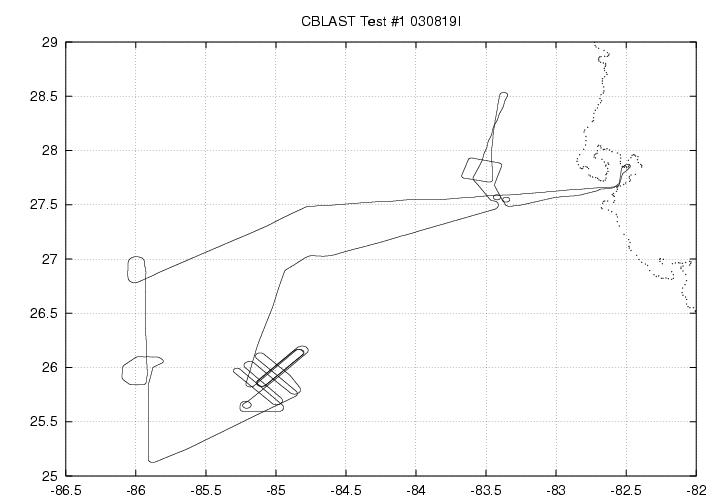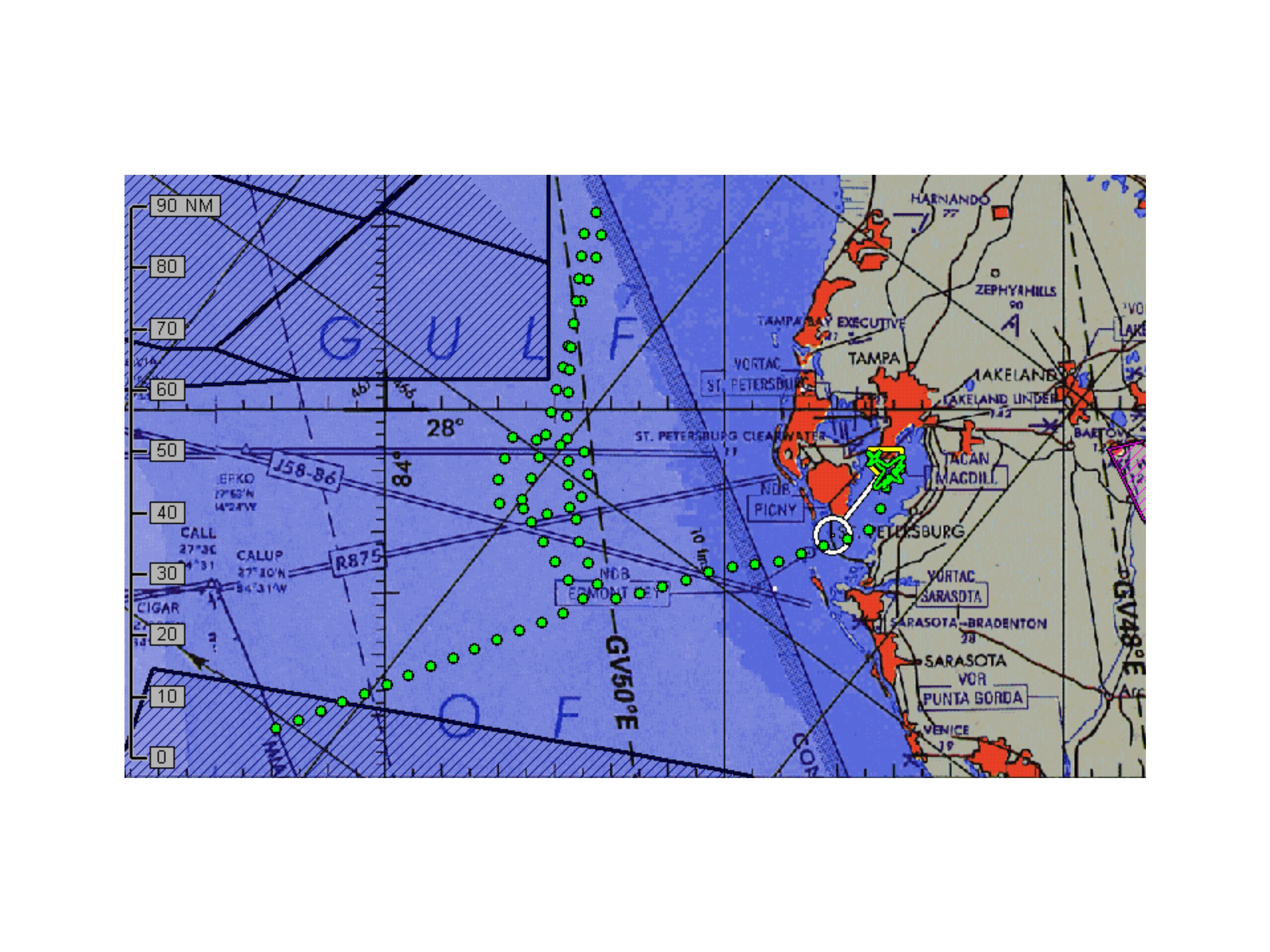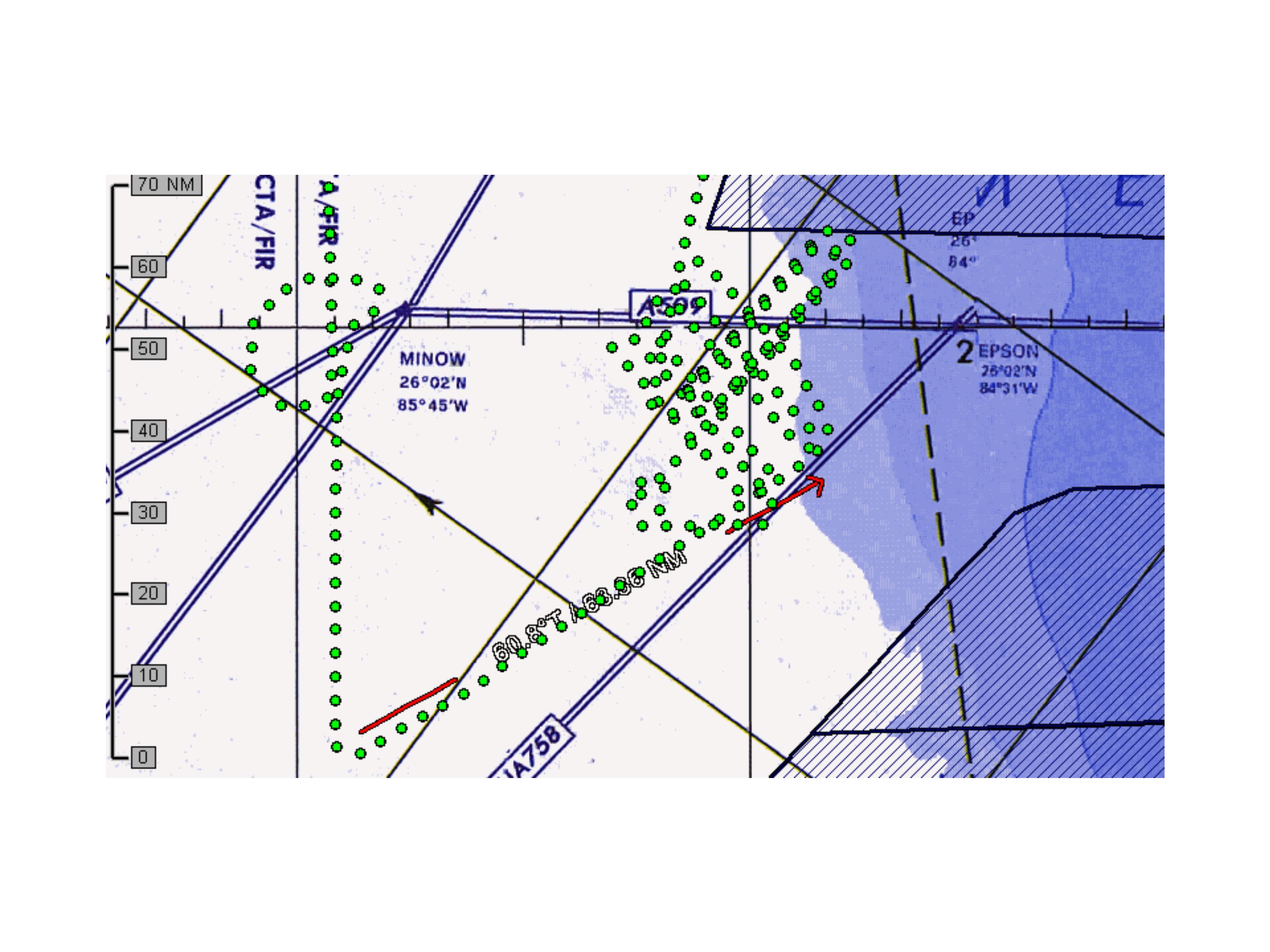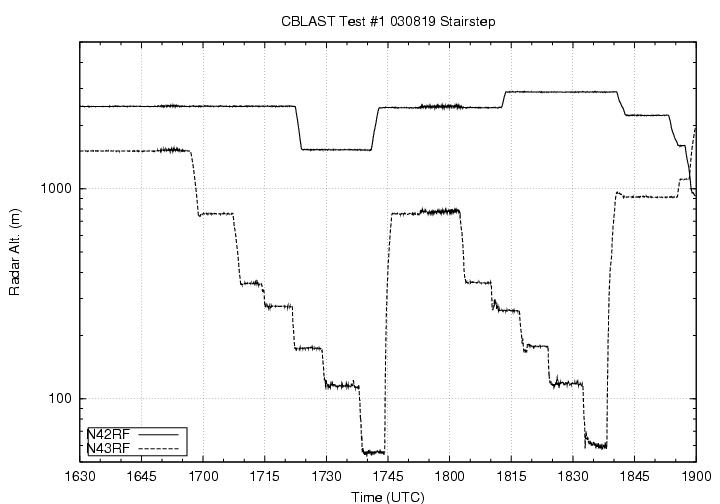 NOAA43 planned to perform a coordinated CBLAST test flight with NOAA42
with a proposed takeoff time of 1500 UTC and a duration of about 5.5
hours. The main objectives of the flight were to execute a simulated
series of eyewall dropsonde and AXBT drops, perform two stepped
descents from 2500 to 200 feet AGL, evaluate the coordination between
P3 aircraft, and perform a series of pitch, yaw, and speed maneuvers
for Bat probe calibrations. Buoy 42003, in the east-central Gulf of
Mexico, was chosen to be the location of a simulated hurricane eye.
NOAA43 would chose an IP 50 nmi north of the buoy at 5,000 ft to begin
a north to south run over the buoy ending up 50 miles south of 42003.
Starting at 30 miles out, 43 would simulate the deployment of 4
dropsondes (the last of which would be an actual drop) and deploy 2
AXBTS at the endpoints of the sonde drop locations. The aircraft would
perform an octagonal pattern for about 10 minutes and within 10 miles
of the buoy to simulate circling in the eye while a new series of
sondes were initialized by the AOC crew. The series of 4 sondes and 2
AXBTS would be repeated on the outbound (south of 42003) leg, right
after 42 released the last of their 8 (7 simulated and one real)
dropsondes. After completing the buoy run, NOAA43 would link up with
42 at a position determined in flight to perform the first of 2 step
descents beginning at 2500 ft, flying upwind and downwind for 20 nmi
per leg at 2500, 1200, 900, 600, 400, and 200 ft AGL. NOAA42 would be flying at 8,000 ft in a trailing pattern during 43’s 2500 ft run.
The stepped descent would then be repeated except the legs would be
oriented crosswind in both directions.
NOAA43 planned to perform a coordinated CBLAST test flight with NOAA42
with a proposed takeoff time of 1500 UTC and a duration of about 5.5
hours. The main objectives of the flight were to execute a simulated
series of eyewall dropsonde and AXBT drops, perform two stepped
descents from 2500 to 200 feet AGL, evaluate the coordination between
P3 aircraft, and perform a series of pitch, yaw, and speed maneuvers
for Bat probe calibrations. Buoy 42003, in the east-central Gulf of
Mexico, was chosen to be the location of a simulated hurricane eye.
NOAA43 would chose an IP 50 nmi north of the buoy at 5,000 ft to begin
a north to south run over the buoy ending up 50 miles south of 42003.
Starting at 30 miles out, 43 would simulate the deployment of 4
dropsondes (the last of which would be an actual drop) and deploy 2
AXBTS at the endpoints of the sonde drop locations. The aircraft would
perform an octagonal pattern for about 10 minutes and within 10 miles
of the buoy to simulate circling in the eye while a new series of
sondes were initialized by the AOC crew. The series of 4 sondes and 2
AXBTS would be repeated on the outbound (south of 42003) leg, right
after 42 released the last of their 8 (7 simulated and one real)
dropsondes. After completing the buoy run, NOAA43 would link up with
42 at a position determined in flight to perform the first of 2 step
descents beginning at 2500 ft, flying upwind and downwind for 20 nmi
per leg at 2500, 1200, 900, 600, 400, and 200 ft AGL. NOAA42 would be flying at 8,000 ft in a trailing pattern during 43’s 2500 ft run.
The stepped descent would then be repeated except the legs would be
oriented crosswind in both directions. Mission Synopsis:
Takeoff from MacDill was at 1509 UTC, only a few minutes past the scheduled time. After coordinating with 42, we reached the IP, 50 nmi north of Buoy 42003, at 1605 UTC, where we were at our planned altitude of 5,000 ft. After dropping 2 AXBTs and 1 dropsonde (plus 3 simulated drops), NOAA43 reached the buoy at 1618 UTC and began the octagonal, circling pattern. At 1633, the aircraft tracked southbound away from the buoy and awaited word from 42 that they had dropped their last sonde before releasing an AXBT and dropsonde, simulating 3 other dropsonde releases, followed by another AXBT. The southbound leg ended at 1639 UTC. A small convective line, SE of the Buoy, was chosen by the scientific crew of 43 during the pass by 42003 as an area to perform the step descents. We coordinated with NOAA42 and reached the beginning of the (simulated) downwind leg at an altitude of 2500 ft at 1701 UTC. The aircraft ascended to 2500 ft at 1744 UTC after completing the planned series of altitudes and headings upwind and downwind (along the convective line). The second series of step descents, flying perpendicular to the cloud line (simulated crosswind), began at 1745 UTC in the same area as the first one. We finished this pattern at 1838 UTC before climbing to 3000 ft and searching for clear air on the way back to Tampa to conduct the BAT probe maneuvers. Despite an abundance of convection that was widespread, we found an area of relatively undisturbed air to try the speed, pitch, and yaw maneuvers. The first of these (yaw) started at 1923 UTC and we ended at 2008 UTC, before finishing the second set of planned pitch maneuvers. We encountered an outflow boundary from a nearby thunderstorm on the approach to MacDill, diverted around it, and landed about 2020 UTC.
Evaluation:
Overall, the test mission was a success: the coordination between aircraft was very good, the timing of the simulated drops apparently only had some minor glitches, and the step descents were performed by the AOC crew nearly flawlessly. Almost all of the BAT probe maneuvers were conducted despite finding only a limited area of clear air on the ferry back. The direction of the up, down, and crosswind legs in the step descents were chosen to be performed relative to the orientation of the convective line rather than according to the wind direction since the winds were light and variable and the vertical shear was much different than what would be expected in a tropical cyclone. This worked well, and we only had to adjust one of out 20 mi legs to avoid weather. We also decided to try a series of left hand turns at the end of each leg in future flights to avoid drifting toward the convection and to align better with the wind (or cloud line). The exact placement of the sequence of 12 simulated and real drops (8 from 43, 4 from 43) will not be known until the flight-level position data is evaluated and dropsonde locations plotted. Based on the log sheets, though, the timing was very good, and a new strategy for the subsequent test flight was planned to make the timing even better. The communication between the scientific crew and AOC flight personnel was excellent both within the plane and between aircraft. The remaining series of pitch maneuvers that were not completed on this flight were planned to be done on the next flight. The mission met the objectives in the planning and briefings and moved AOC, HRD, and CBLAST scientists a step closer to performing CBLAST flights into hurricanes.
Problems:
The SRA did not function on the flight despite efforts from Ed Walsh to revive the instrument. The radar systems worked well except for an apparent low bias of about 15 dBZ on both the LF and tail radar systems . The radar tape was also defective as determined by AOC staff after the flight. The HRD workstation was installed but not yet operational. Minor timing and coordination issues needed (and were) to be worked out after the flight. Despite concerns about the data system’s reliability, it operated continuously. None of the problems encountered were enough to warrant a delay of the second planned flight or to prevent the aircraft from completing a mission.
Michael Black


